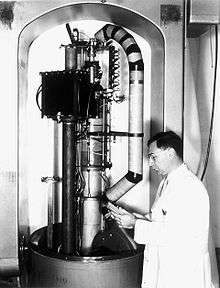Henry Kaplan (doctor)


Henry Seymour Kaplan MD (born in Chicago on April 24, 1918, died in San Francisco on February 4, 1984) was a radiologist who pioneered in radiation therapy and radiobiology.
Together with Edward Ginzton, he invented the first medical linear accelerator in the Western hemisphere while he worked at the Stanford University Medical Center of Stanford University. The six million volt machine was first used in 1955, six months after another model was first used in England.
The first patient treated by Dr. Kaplan was Gordon Isaacs, who suffered from retinoblastoma of his right eye, and the disease threatened his left eye. The patient survived into adulthood with normal vision in his left eye. His main focus was on Hodgkin's disease, which was fatal before radiation therapy was used.
Kaplan earned his degree from Rush Medical College in Chicago, after which he trained at the University of Minnesota, Yale University and the National Cancer Institute. He once said he became interested in oncology after his father died of lung cancer, the same disease which killed Dr. Kaplan, a non-smoker.
In 1969, he became the first physician credited with the Atoms for Peace Prize. He was the first radiologist elected to the National Academy of Sciences in 1972. In 1979, he received the Charles F. Kettering Prize from the General Motors Cancer Research Foundation.
References
- Charlotte DeCroes Jacobs. Henry Kaplan and the Story of Hodgkin's Disease (Stanford University Press; 2010) 456 pages; combines a biography of Kaplan with a history of the lymphatic cancer whose treatment he helped to transform.
- LAWRENCE K. ALTMAN. DR. HENRY KAPLAN, CANCER-FIGHTER, IS DEAD. New York Times, February 6, 1984.
- Malcolm A. Bagshaw, Henry E. Jones, Robert F. Kallman, Joseph P. Kriss. MEMORIAL RESOLUTION HENRY S. KAPLAN (1918 – 1984). Stanford Historical Society. Retrieved December 27, 2008.
- Mitzi Baker. Medical linear accelerator celebrates 50 years of treating cancer. Stanford School of Medicine. Retrieved December 27, 2008.
|